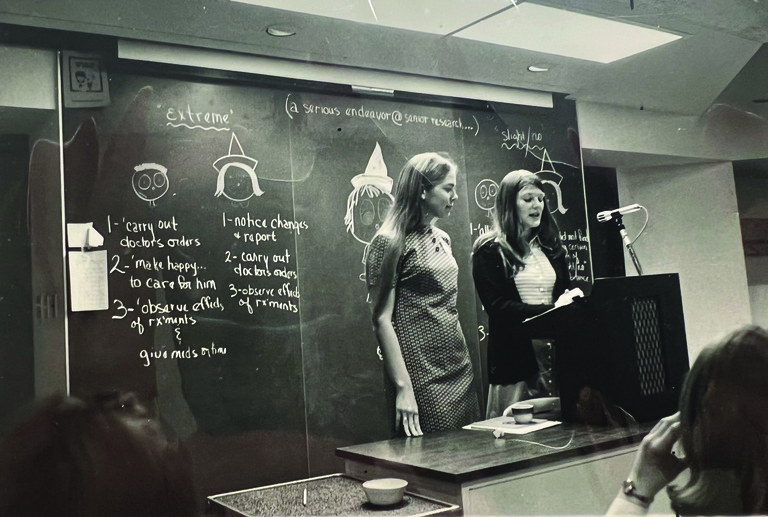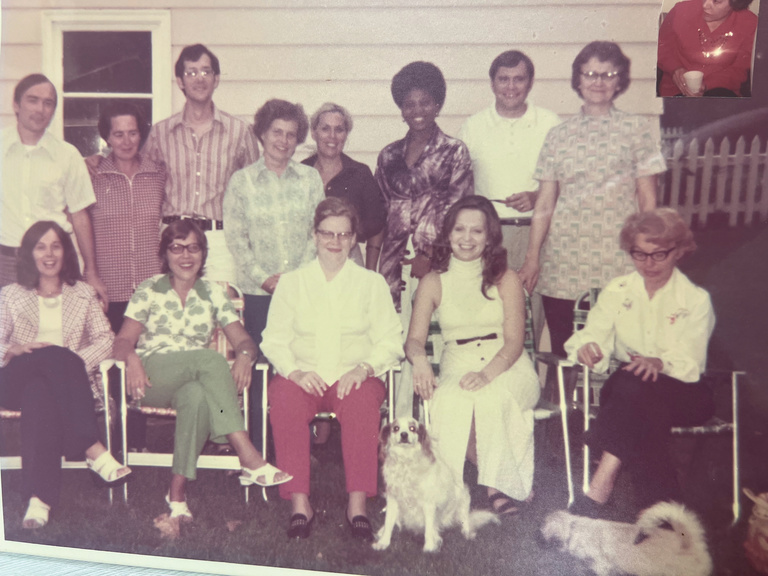Main navigation

Dean Dustan submitted her resignation in December 1970, and Evelyn Barritt, formerly the dean of the Capital University School of Nursing in Columbus, Ohio, was confirmed as the new dean in March 1972.
After seven years of work, a new curriculum based on the nursing process was implemented with the sophomore class in 1974. Nursing students would, the curriculum stated, “approach nursing as a process directed toward the maintaining as well as regaining health of individuals and groups.” Other undergraduate curriculum changes included the additional focus on gerontological nursing and a shift towards community-based instruction, as the health care market became more outpatient and clinic focused.
The college began its first nurse practitioner program in 1972. Co-founded by Toni Clow (66BSN, 75MA) from the College of Nursing and Brenda Cruikshank from the College of Medicine, the pediatric nurse practitioner program was a 16-week program offered twice a year to certificate and graduate students. Following national trends to make graduate education more accessible to working nurses, the college also began exploring extension options in the 1970s. Statewide surveys indicated a great interest and, with support from a federal grant, a medical-surgical graduate program started in Des Moines in 1976.

Dean Barritt ended her term in 1979, and Geraldene Felton assumed the position of dean in 1981. Felton, a military nurse of nearly 30 years earned her Doctor of Education from the New York Department of Nursing in 1969 and was one of the Charter Fellows who launched the American Academy of Nursing in 1973. In a 1996 interview, Felton said she accepted the deanship at the College “because of the challenge,” and by all reports she met the challenge in an effective manner, building a strong foundation of research and scholarship for the college’s future.
A 1982 strategic plan outlined a shift in the college’s priorities to focus on perfecting curricula, recruitment of “a faculty of quality educational excellence, academic distinction, and diversity,” and pursuit of extramural support for research and instruction.
I entered the College of Nursing as a second-year transfer student and loved being there. I was from a small town, Indianola, Iowa, and it was mind boggling to me how big the university was. I had excellent professors and clinical oversight. Some of the names that come back to me are Marty Craft-Rosenberg, Kitty Buckwalter, Jo Eland, and Pat Donahue.
The dean at the time was Geraldene Felton, and even just saying her name makes me want to stand up straighter. She was amazing and strong, and she told us all as students that we would be leaders. Of course, we didn’t really take that I think as
As dean, Felton also centered her efforts on the development of younger faculty and the recruitment of new faculty with a solid research background. Her strategies proved successful, and the number of faculty holding doctoral degrees grew from 25 percent in 1982 to 60 percent in 1995. In 1995, 81 percent of those faculty with doctoral degrees had earned them from the University of Iowa. This focus also led to an emphasis on and dramatic growth in research at the college.

Extramural research funding, about $10,000 in 1980, rose to more than $400,000 in 1984. In 1993, the college’s research funding passed $1 million, reaching more than $2 million by 1995. Grant submissions increased nearly ten-fold, from $850,000 in 1983-84 to more than $8 million in 1988-89, and faculty publications increased nearly four times, from 40 in 1979 to 146 in 1994.
Graduate enrollment more than doubled from 1980 to 1994, and an increasing number of part-time students took advantage of the satellite programs. Gerontological and anesthesia nursing programs were added in the 1990s, bringing the total clinical specialties offered to five.
Discussions of establishing a doctoral program at the College of Nursing began in the 1970s. A 1976 feasibility study assessed aspects such as demand and resources and determined that a doctoral program was “imperative” at some point in the near future, as doctoral preparation for nurses was the way of the future. The study also found that faculty education and research productivity had to be increased substantially for a program to be established.
In 1985, there were 31 nursing PhD programs in the U.S., and another PhD feasibility study was conducted at the college. The study report determined that the college, with 27 faculty holding doctoral degrees, a firm base of ongoing research projects, and a solid record of publications, was ready to establish a program. Seven students enrolled in the first PhD in Nursing program in 1988, which included concentrations in gerontological nursing and nursing administration. Key faculty in nursing administration included Joanne McCloskey, Myrtle Kitchell Aydelotte, and Meridean Maas (57BSN, 60MA), while the gerontological concentration was led by Toni Tripp-Reimer and Kathleen “Kitty” Buckwalter (71BSN, 76MA). The first four College of Nursing PhDs were awarded in spring 1992, with another ten awarded in the next four years.

1972
Co-founded with the College of Medicine, the first nurse practitioner program begins, focused on pediatrics.
1972
Evelyn R. Barritt, PhD, RN, becomes dean.
1973
Diamond Jubilee of the College of Nursing is celebrated in May
1977
- Endowed chair established by gifts in memory of John Christian Kelting and Catharine Meeder Kelting.
- Nursing Progress Fund established through the University of Iowa Foundation.
1976-1978
Dean Barritt serves as president of the American Academy of Colleges of Nursing.

1981
Geraldene Felton, EdD, RN, FAAN, becomes dean.
1983-1987
Dean Felton serves as president-elect and president of the American Academy of Colleges of Nursing.
1984
Office of Nursing Research established.

1988
PhD program begins with concentrations in Nursing Administration and Gerontological Nursing.
March 15, 1990 An article in The Cedar Rapids Gazette details a research fellowship from the National Institutes of Health. Hayden Rios-Iturrino (92PHD) was one of the first graduates of the college’s PhD program.
1989
Research collaboration between UIHC and the college is formalized.

1991
Iowa passes law vesting certified nurse practitioners with authority to prescribe medication in their area of specialty.
1994
- Nurse anesthesia program begins as a Master of Science in Nursing.
- Gerontological Nurse Practitioner program begins.

1994
The precursor to the 2001 Iowa Model of Evidence-Based Practice is published.

1995
- Master of Arts degree with major in nursing changed to a Master of Science in Nursing.
- The Center for Nursing Classification and Clinical Effectiveness, an Iowa Board of Regents-approved Center, is established. (2022 photo)
1998
The college celebrates 100 years with a two-day event titled “Nursing Education at the University of Iowa: Sustaining a Tradition”
